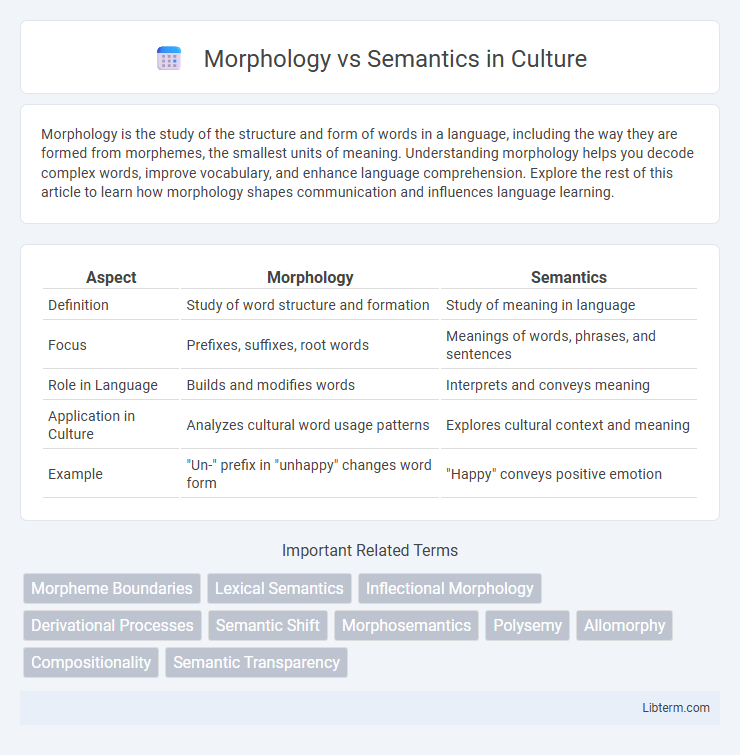Morphology is the study of the structure and form of words in a language, including the way they are formed from morphemes, the smallest units of meaning. Understanding morphology helps you decode complex words, improve vocabulary, and enhance language comprehension. Explore the rest of this article to learn how morphology shapes communication and influences language learning.
Table of Comparison
| Aspect | Morphology | Semantics |
|---|---|---|
| Definition | Study of word structure and formation | Study of meaning in language |
| Focus | Prefixes, suffixes, root words | Meanings of words, phrases, and sentences |
| Role in Language | Builds and modifies words | Interprets and conveys meaning |
| Application in Culture | Analyzes cultural word usage patterns | Explores cultural context and meaning |
| Example | "Un-" prefix in "unhappy" changes word form | "Happy" conveys positive emotion |
Introduction to Morphology and Semantics
Morphology studies the structure and formation of words by analyzing morphemes, the smallest meaningful units in a language, which helps understand word construction and variation. Semantics focuses on the meaning conveyed by words, phrases, and sentences, exploring how language expresses concepts, ideas, and relationships. Both morphology and semantics are essential components in linguistics for decoding the structure and meaning of language.
Defining Morphology: The Structure of Words
Morphology examines the internal structure of words, focusing on morphemes--the smallest units of meaning such as roots, prefixes, and suffixes--that combine to form complex words. It analyzes how these units interact to convey grammatical functions like tense, number, and case, shaping word formation and modification. Distinct from semantics, morphology centers on word construction rather than meaning interpretation, providing the framework for understanding linguistic form.
Understanding Semantics: The Meaning of Words
Understanding semantics involves analyzing the meaning conveyed by words, phrases, and sentences within a language, focusing on how meaning is constructed and interpreted. Unlike morphology, which examines the structure and formation of words through morphemes, semantics delves into the relationships between words and their meanings, including connotations, denotations, and contextual usage. This study enables effective communication by clarifying ambiguous expressions and facilitating precise interpretation in various linguistic contexts.
Key Differences Between Morphology and Semantics
Morphology studies the structure and formation of words, analyzing morphemes--the smallest units of meaning or grammatical function--while semantics focuses on the meaning and interpretation of words and sentences in context. Key differences include morphology dealing with word composition and grammatical variations, whereas semantics addresses the significance and relationships of meaning within language. Understanding morphology helps in parsing word forms, whereas semantics is essential for grasping meaning, idiomatic expressions, and contextual nuances.
The Relationship Between Morphology and Semantics
The relationship between morphology and semantics is fundamental in understanding language as morphology studies the structure and formation of words while semantics focuses on meaning. Morphological elements like prefixes, suffixes, and roots directly influence semantic interpretation by altering or specifying a word's meaning. This interplay allows for the creation of nuanced expressions and the generation of new words that convey precise concepts within a language.
Morphological Processes and Their Impact on Meaning
Morphological processes such as affixation, reduplication, and compounding alter the structure of words and can significantly impact their meaning by creating new lexical items or grammatical forms. These processes enable languages to generate variations of root words that express tense, number, mood, or derivation, thereby enriching semantic interpretation. Understanding how morphology modifies meaning is crucial for analyzing language acquisition, lexical semantics, and computational linguistics.
Semantic Change and Morphological Variation
Semantic change involves shifts in word meanings over time, influencing how language conveys concepts and cultural values. Morphological variation refers to differences in word structure, such as inflectional or derivational changes, which affect meaning and grammatical function. Both phenomena interact dynamically, shaping linguistic evolution by altering vocabulary and the relationships between form and meaning.
Applications in Linguistic Analysis
Morphology examines the structure and formation of words, identifying morphemes such as roots, prefixes, and suffixes, which aids in parsing complex vocabulary and understanding language patterns. Semantics focuses on meaning, interpreting how words, phrases, and sentences convey concepts and relationships, essential for tasks like sentiment analysis and machine translation. Combining morphological analysis with semantic interpretation enhances natural language processing applications by improving accuracy in text understanding and information extraction.
Challenges in Distinguishing Morphology from Semantics
Distinguishing morphology from semantics presents challenges due to the interconnected nature of form and meaning in language processing. Morphological analysis focuses on the structure and formation of words, while semantics deals with the interpretation of meaning, yet morphemes can carry both syntactic and semantic information, leading to ambiguity. Complex cases such as polysemy, homonymy, and derivational morphology blur the boundaries, requiring advanced computational models and linguistic frameworks to accurately separate morphological structures from semantic content.
Conclusion: Bridging Form and Meaning
Morphology analyzes the structure and formation of words, while semantics examines their meanings and interpretations. Bridging morphology and semantics enhances natural language understanding by linking word forms to contextual meaning. Integrated approaches improve computational linguistics, enabling more accurate language processing and nuanced communication analysis.
Morphology Infographic

 libterm.com
libterm.com